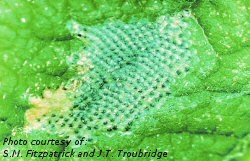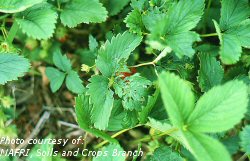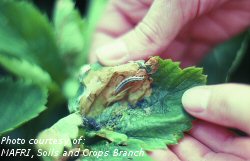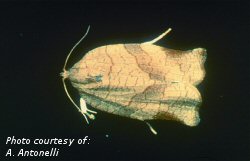Leafrollers II

Oblique banded leafroller egg mass

Leafroller damage to strawberry

Leafroller larva in strawberry leaf

Oblique banded leafroller adult
Host Plants And Distribution
There is a tremendous variety of leafrolling caterpillars that feed on a wide variety of host plants and are found throughout North America. Strawberries, raspberries, saskatoons and chokecherries are all attacked by leafrollers.
Biology
Depending upon the species involved, either larvae or pupae will overwinter. The adults emerge in late April and early May, mate and deposit eggs on the newly emerged foliage. Young larvae feed on unfolded leaves, while the older larvae fold the leaves in half and web them together. They then feed within the rolled leaf. There may be as many as three generations per year.
Symptoms And Damage
Damage is caused by feeding outside and within the rolled leaves. The leaves may turn brown and die. Fruit is rarely attacked and only when populations are very high. Damage in the Canadian Prairies is generally minimal.
Scouting Techniques
Damage is easily visible as rolled and webbed leaves. Rolled leaves should be picked and inspected for presence of larvae. If no larvae are present, it is too late for control measures.
Economic Thresholds
Control measures in the Prairies are usually not required. Healthy plants have numerous leaves and loss of a small number of leaves will have little impact on fruit production. Removal and destruction of infested leaves is sufficient to control low populations of these pests. If infestations are higher than 10% of the leaves, control measures should be undertaken.

